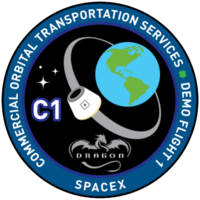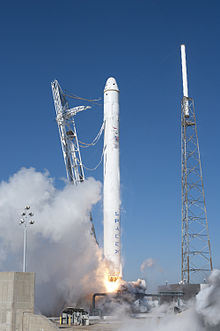- COTS Demo Flight 1
-
COTS-1 
Mission logoOperator SpaceX Mission type Demonstration Launch date December 8, 2010, 10:43 a.m. EST Carrier rocket Falcon 9 Launch site LC-40, CCAFS Mission duration 3:19:52 Mission highlight First commercial company to recover a reentering spacecraft Landing December 8, 2010, 2:02 p.m. EST Landing site Pacific Ocean,
approx. 500 mi (800 km) west of Baja, MexicoHomepage http://www.spacex.com/dragon.php Orbital elements Regime Low Earth orbit Inclination 34.53 Degrees Altitude 288 × 301 km (179 × 187 mi) Orbital period < 2 planned, 3 contingency References: [1][2][3][4] COTS Demo Flight 1 was the unmanned first spaceflight of the SpaceX Dragon spacecraft, the Dragon C1, which orbited the Earth, and the second overall flight of the SpaceX Falcon 9. It was also the first demonstration flight for NASA's Commercial Orbital Transportation Services (COTS) program for which SpaceX was selected.[5] The primary mission objectives were to test the orbital maneuvering and reentry of the Dragon capsule. The mission also aimed to test fixes to the Falcon 9 rocket, particularly the unplanned roll of the first stage that occurred during Flight 1. The capsule was carried to orbit by a Falcon 9 rocket, which made its second scheduled launch.[3] Liftoff occurred on December 8, 2010, at 10:43 a.m. EST (1543 GMT).[3]
The success of the mission has allowed SpaceX to advance its vehicle testing plan. With the two back-to-back "near-perfect" Falcon 9 launches (including Falcon 9 Flight 1 in June) "and the successful orbital operation, reentry and parachute landing of its first Dragon capsule" SpaceX "will ask NASA to combine objectives laid out for the remaining two COTS missions ... and permit a docking at the [space station] during its next flight, targeted for mid-2011."[6]
Contents
COTS Contract
On August 18, 2006, NASA announced that SpaceX had won a NASA Commercial Orbital Transportation Services (COTS) contract to demonstrate cargo delivery to the International Space Station with a possible option for crew transport.[7] This contract, designed by NASA to provide "seed money" for development of new boosters, paid SpaceX $278 million to develop the Falcon-9 launch vehicle, with incentive payments paid at milestones culminating in three demonstration launches.[8] COTS Demo Flight 1 was the first of the launches under this contract. The original agreement with NASA called for the COTS Demo Flight 1 to occur the second quarter of 2008; this flight was delayed several times, actually occurring in December 2010.[5]
Separately from the NASA COTS contract, SpaceX was also awarded a NASA contract for commercial cargo resupply of Space Station ("CRS"). The firm contracted value is $1.6 billion, and NASA may elect to order additional missions for a total contract value of up to $3.1 billion.[9]
Preparations
The two stages and Dragon capsule for the second Falcon 9 were built at SpaceX's manufacturing facility at Hawthorne, California, and were delivered to SpaceX's facilities at Cape Canaveral in July and August 2010.[4]
Target launch date was rescheduled from its original 2008 date to the end of 2010, with COTS Demo 2 and 3 being rescheduled to 2011.[4]
A full wet dress rehearsal was conducted on September 15, 2010, and launch was targeted for no earlier than December 7, 2010.[10]
On November 22, 2010, SpaceX announced that it had received a license for spacecraft re-entry from the Federal Aviation Administration's Office of Commercial Space Transportation for the flight. It is the first such license issued to a private enterprise.[11]
A successful static test fire was performed by SpaceX on December 4, 2010. This was the third attempt to do so, as the first two attempts were automatically aborted. The first attempt was on December 3, 2010, but the test was automatically aborted one second before ignition due to a high-pressure reading.[citation needed]
The flight was to proceed on December 7, 2010. However, several cracks were noted on the outer portions of the niobium extension of the second stage Merlin Vacuum nozzle. The decision was made to trim the un-needed four feet off the nozzle, since the resulting performance loss was not critical. SpaceX technician Marty Anderson flew to Cape Canaveral to perform the cut.[12]
Launch events
Video of launch
The launch was ultimately scheduled for December 8, 2010, with launch windows available from 9:00 to 9:06 a.m., 10:38 to 10:43 a.m., and 12:16 to 12:24 p.m. EST based on the availability of the NASA Tracking and Data Relay Satellite (TDRS) network used to track and communicate with the spacecraft. The first attempt was originally scheduled for the middle of the first launch window, at 9:03, but was moved to the end of the window at 9:06 a.m. EST. This attempt was aborted with 2:48 left in the countdown clock because of false telemetry data.
The launch was re-targeted for 10:43 a.m. EST, and was successful.[13] First stage engines cut off at T+2:56, nose cone separated at T+3:47, second stage engines cut off at T+8:56, all as planned. The Dragon vehicle separated at T+9:30 and achieved a near circular orbit, with a perigee of 288 kilometres (179 mi) and an apogee of 301 kilometres (187 mi) and an inclination of 34.53 degrees. These were close to targeted marks of a 300 kilometres (190 mi) circular orbit at an inclination of 34.5 degrees.
Attempt Planned Result Turnaround Reason Decision point Weather go % Notes 1 8 Dec 2010, 9:06:00 am Aborted --- Automated abort on fault detected in ordnance interrupter[citation needed] 8 Dec 2010, 9:03 am(T-2:48[14]) 80%[15] 2 8 Dec 2010, 10:43:00 am Successful 0 days, 1 hours, 37 minutes 80%[15] Additional payloads
The Falcon 9 carried a small number of nanosatellites to orbit as well. Included were the first U.S. Army nanosatellite, Space and Missile Defense Command - Operational Nanosatellite Effect, or SMDC-ONE, for a 30-day mission,[16][17][18] and two 3U buses, the CubeSat Experiment (QbX), provided by the U.S. National Reconnaissance Office, also expected to remain in orbit for only 30 days.[19]
One of the weight ballasts inside the Dragon spacecraft was a metal barrel containing a wheel of French Le Brouère cheese. This cheese is produced in Bulgnéville, Vosges. It was packed as a joke, and references the Cheese Shop sketch from Monty Python's Flying Circus. The barrel's lid was pasted with an image from the poster for the 1984 spoof film Top Secret![20]
Orbit and landing
Dragon
While in orbit, a battery of automated tests were performed including thermal control and attitude control to maintain uninterrupted TDRS data links. At 11:15 am, SpaceX announced that it had achieved contact with the Dragon module through the TDRS system. After the two planned orbits and a flight time of 3:19:52 the craft was manually de-orbited, and splashed down in the Pacific Ocean at 2:02 p.m. EST approximately 800 kilometres (500 mi) west of Baja California after all three parachutes successfully deployed.[14] SpaceX reports that all test objectives were completed, and the recovery craft arrived to retrieve the spacecraft within 20 minutes of splashdown. The craft landed within 800 metres (2,600 ft) of the targeted location, well within the 60-by-20-kilometre (37 by 12 mi) recovery zone.[14]
Second stage
The second stage engine was reignited in orbit after separation from the Dragon capsule. This allowed SpaceX to work on a secondary mission objective of expanding the launch capability envelope by testing in-space engine reignition and ability of the vehicle to achieve a beyond-LEO orbit. Even though the nozzle of the Merlin Vacuum second-stage engine had been substantially trimmed—due to two cracks discovered only a few days before the scheduled launch—the second stage reached an altitude of 11,000 kilometres (6,800 mi).[6]
See also
References
- ^ "Launch Manifest". http://www.spacex.com/launch_manifest.php.
- ^ "Commercial Orbital Transportation System (COTS)". NASA. http://www.nasa.gov/offices/c3po/home/cots_project.html. Retrieved 2 December 2010.
- ^ a b c "COTS Demo Flight 1 Press Kit". SpaceX. http://www.spacex.com/downloads/cots1-20101206.pdf.
- ^ a b c "SpaceX: Dragon testing will determine launch schedule". Spaceflight Now. http://spaceflightnow.com/falcon9/002/100820update/. Retrieved 20 August 2010.
- ^ a b NASA COTS contract (pdf), signed 8/18/2006 (Accessed 30 December 2010)
- ^ a b Klotz, Irene (2010-12-13). "SpaceX Sees ISS Meet-up in 2011". Aviation Week. http://www.aviationweek.com/aw/generic/story_channel.jsp?channel=space&id=news/awst/2010/12/13/AW_12_13_2010_p22-275434.xml. Retrieved 2011-02-08. "The second stage went up to 11,000 km.—and that’s with the shortie skirt"
- ^ "SpaceX wins NASA COTS contract to demonstrate cargo delivery to Space Station with option for crew transport" (Press release). SpaceX. August 18, 2006. http://www.spacex.com/press.php?page=25.
- ^ Remarks by Alan Lindenmoyer, Manager, NASA Commercial Crew & Cargo Program, Minutes of the NAC Commercial Space Committee, April 26, 2010 (accessed Dec. 1, 2010]
- ^ "NASA SELECTS SPACEX'S FALCON 9 BOOSTER AND DRAGON SPACECRAFT FOR CARGO RESUPPLY," SpaceX Press Release, December 23, 2008] (accessed 30 December 2010)
- ^ "World Wide Launch Schedule". Space Flight Now. http://www.spaceflightnow.com/tracking/index.html. Retrieved 14 November 2010.
- ^ "FAA Awards Spacex First Ever Commercial License to Re-enter Spacecraft from Orbit". SpaceX. http://www.spacex.com/press.php?page=20101122. Retrieved 2 December 2010.
- ^ "Cheese in Space, and Other Tasty Tales of the SpaceX Dragon LAUNCH". http://satellite.tmcnet.com/topics/satellite/articles/125461-cheese-space-other-tasty-tales-the-spacex-dragon.htm.
- ^ "Launch of SpaceX craft could be milestone for privatized space flight". CNN. http://www.cnn.com/2010/US/12/08/space.flight/index.html?hpt=T2.
- ^ a b c "COTS Demo Flight 1 status". SpaceFlight Now. http://www.spaceflightnow.com/falcon9/002/status.html.
- ^ a b "Launch Operations Forecast - Falcon 9 Dragon COTS Demo 1". United States Air Force. http://www.patrick.af.mil/shared/media/document/AFD-070716-028.pdf.
- ^ Army Nanosatellite On First Flight SpaceDaily, 2010-12-10, accessed 2010-12-18.
- ^ Cosmic Log
- ^ http://www.cubesatkit.com/content/space.html
- ^ NRL launches nano-satellite experimental platforms, PhysOrg news, 2010-12-17, accessed 2010-12-18.
- ^ Malik, Tariq (2010-11-02). "Wheel of Cheese Launched Into Space On Private Spacecraft". Yahoo! News. http://news.yahoo.com/s/space/20101209/sc_space/wheelofcheeselaunchedintospaceonprivatespacecraft. Retrieved 2010-12-10.
SpaceX Vehicles Engines Launch Sites Missions Falcon 1Falcon 9Falcon HeavyFlight 1 (2013)Dragon/COTSContracts Categories:- SpaceX
- 2010 in spaceflight
- Spacecraft launched by Falcon rockets
Wikimedia Foundation. 2010.

